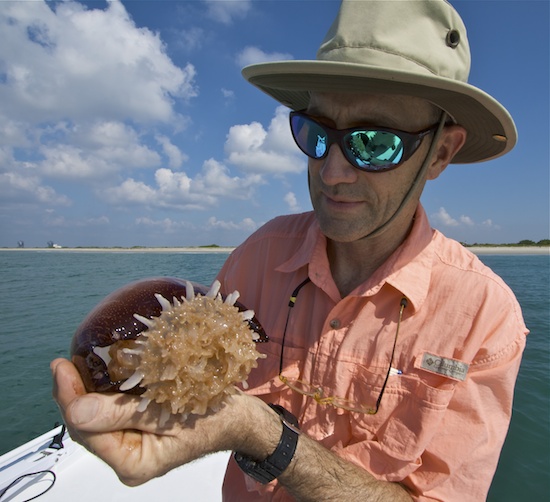Choosing Polarized Sunglasses for Fishing
The process of choosing sunglasses for fishing can be confusing and frustrating. It can also be an adventurous, educational experience- searching, reading, inquiring, trying, feeling, fitting, seeing, looking, and finally, choosing. If you’re aware of just a few important points you can not only make the process fun, but also insure you will actually choose the glasses that will best suit your needs.
A polarizing lens, essential for fishing and highly desirable for driving, acts something like a microscopic set of blinds, eliminating all wavelengths of light that are not parallel to the line of the filters within the lens. By doing so they eliminate glare, making it possible to see into the water, and reduce eyestrain on an angler or driver.
It is essential to understand what the “right” glasses are. Simply put, the best sunglasses are the ones that you will actually want to wear when outdoors.
Drew Simmons of Smith Optics says, “Choosing the right glasses comes down to three things- fit, lens color and material, and frame style and color.”
Fit and comfort are crucial. Take time to try on sunglasses. Consider how they feel. They should be comfortable and secure. If you’re a fisherman they should eliminate most light that might come in from around the periphery of the frame. They should not be sliding down your nose, pinching your temples, or hurting your ears. A high performing, UV blocking lens does not protect you if it’s not on your face. Your glasses should fit so well that you forget they are there.
Lenses present a more complex topic. First of all, lenses are made of various materials including glass and different types of plastic. Glass is the heaviest, but is also the most scratch resistant. Glass lenses are not shatterproof. If you hit yourself in the face with a jig those glasses could break, with predictably ugly results.
Two types of plastic are used in quality eyewear, polycarbonate and high index plastic. Polycarbonate, the safest material, is 10 times more impact resistant than other materials. It’s also the lightest material weight-wise. High index plastic offers better peripheral vision than does polycarbonate. Both scratch easily and need a coating to increase scratch resistance
The next consideration is lens color. Let us state (somewhat arbitrarily) that there are four basic colors of polarized lenses: dark brown, light brown, green, and gray. Some companies have vermillion, copper, amber, and other colors. These are simply variations of our basic four.
Fishermen never want a green lens. They don’t provide enough contrast under any conditions for spotting fish. Dark brown is best for inshore fishing in bright sunlight.
Light brown lenses are best for inshore fishing in dim light or under overcast conditions. Offshore anglers prefer gray lenses, which eliminate the blue color of the water and let fish “pop.” If you’re wealthy you should have all three. Otherwise pick the color which works best in the conditions under which you normally fish. I wear dark brown lenses, since my prescription lenses dramatically increase the cost of my glasses.
Some companies now offer photochromic lenses that get darker or lighter in response to the intensity of the light hitting them. While these cost more, they make a single pair of glasses more versatile, and may be a better value than two different pairs of glasses.
You make a fashion statement with your frame style and color. While these don’t directly affect the performance of the glasses (except for helping the fit), they do affect how often you’ll wear the glasses. How we see ourselves and how we seek to enhance our appearance is for many the most important factor in maximizing actual use. Take the time to find frames that you really like.
Don’t get distracted by comparing UV performance claims. Any quality pair of sunglasses will have more than adequate UV blockage.
Eyewear manufacturers who make quality sunglasses specifically targeted at anglers include Hobie, Costa del Mar, Smith Optics, Ocean Waves, and Bolle.
The enormous variety of sunglasses available is what allows you to find the best sunglasses for you. Use this to your advantage when Choosing Polarized Sunglasses for Fishing, the ones you’ll always wear when out of doors.
All content in this blog, including writing and photos, copyright John Kumiski 2013. All rights are reserved.
|

which ones do you wear and why?
i’ve worn the same pair of ocean waves for years. glass lenses! they have great customer service and used to give guides a hefty discount
I have worn Ocean Waves (Chicago Model) for at least ten years. I have lost track of how many times the company has replaced the frames for free…and they turn them around in about a week. I own three pair. Two Amber and one Grey. I wear them everywhere except flying because polarized lenses do not work well with many of the new display screens in avionics and boating electronics…..I can deal with it in the boat but chose not to in the airplane.
There is a new brand of High Quality Italian Made Sunglasses. The company name is SKELETON Optics. They have very reasonable prices and the optics are as good as the big brands. Most of the lenses come from Carl Ziess or BNL (They make Costa Lenses)Give them a look at http://www.skeletonoptics.com. I think that you will find a great company and product for a even better price.
Dave Reed (professional guide) has an online shop specializing in polarized fishing sunglasses with free shipping and handling and excellent customer service. Check them out at http://www.opticians-choice.com .